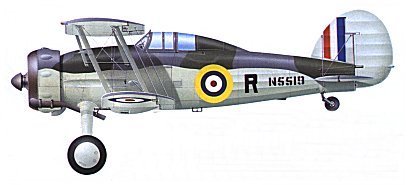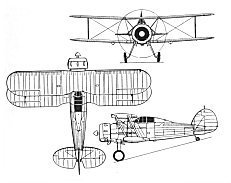


|
Page-8
|
|
BRITISH AIRCRAFT |
 |
 |
|
|
For its day, the Gloster Gladiator was not only pretty to look at, but was a beautiful aircraft to fly, providing
that you were not being chased by a Messerschmitt Bf109 at the time. Also, the sound from the Mercury radial engine was a delight to the ear.
The Gladiator was manufactured by the Gloucestershire Aircraft Company who, back in 1920 acquired the design rights to the French Nieuport Nighthawk fighter aircraft after that company closed down. With this acquisition came numerous spare parts and component stocks of the aircraft. In 1921, The Gloucester Aircraft Company received a contract to construct 50 of the Nighthawks for the Imperial Japanese Navy modified for use as a naval aircraft, plus an additional 40 aircraft that would be supplied in component form to the Yokosuka Air Arm. This order was fulfilled and completed within six months and although the original designation of this aircraft was known as Mars II, it was given the name Sparrowhawk at a later date. The Gloucester Aircraft Company went on to bigger and better things as the years went by. The Sparrowhawk gave way to the Nighthawk in 1921, the Nightjar powered by a Bentley engine was first delivered to the RAF in May 1922, the Grouse trainer in 1922 followed by the Grebe in 1923, the Gamecock in 1925, the Gorcock in 1927, the Guan in 1926 the same year that the Gloucester Aircraft Company changed its name to Gloster Aircraft, the Gambit in 1927, the Gnatsnapper in 1928 and the Gauntlet in 1929. It was a derivative of the Gauntlet that the Gladiator was built, being a private venture to specification F.7/30 and first flew as a prototype on 12th September 1934 and then only known as the SS37. It began series production to Specification F.14/35 in July 1935 and the first flight of the Gloster Gladiator was made in the January of 1937. Because of the outbreak of the second world war, production of the Gladiator was only short lived. It never did prove itself as a fighting machine and were classed as death traps against the Luftwaffe Bf109s very early in W.W.II. Only two marks were made, the Mark I and Mark II. The Mark I was powered by a single 830hp Bristol Mercury radial engine of nine cylinders. Armament was four Browning .303 guns. two mounted in the fuselage and two mounted on the wings. Only 378 Mark I's were built. The Mark II varied little from the Mark I, except that the Bristol Mercury was of improved design and put out an extra ten horsepower and designated the VIII AS. A number of the Mark II's were constructed to naval specifications and were known as Sea Gladiators. Many Gladiators found their way overseas both air force and naval use. In all, a total of 749 Gladiators were manufactured. The table below shows the number of Gladiator Mark I and II's exported.
In early September of 1939, two squadrons flew Gloster Gladiators in France. These were The County of Durham 609
Squadron and the County of Surrey 615 Squadron both were squadrons of the Auxiliary Air Force. Both suffered heavy casualties in the heavy engagements that they undertook. Being
slow in both speed and in manoeuvrability, the gunners of the German bombers found them easy targets and up against the more modern swift monoplane of the Luftwaffe they were totally outclassed.
When the war moved to the south coast of Britain, Gladiators again became involved, but this time only on a minor scale. But the story was much the same as it had been before, they were being shot down like targets on a practice range. They were eventually withdrawn to areas where they would not be used in combat operations.
From the archives: The Date: April 1940. The Theatre: Invasion of Scandinavia. On April 21 1940, No.263 Gladiator Squadron sailed for Norway in the aircraft
carrier H.M.S. Glorious. None of its 18 pilots had ever done a deck landing or a take off before, so Fleet Air Arm pilots
flew the 18 Gladiators on board with them. At 1700 hours on
April 24th, 50 miles (80 km) seaward of Trondheim, the RAF pilots flew them off, each flight of nine led by a naval Skua two seater, which carried a navigator, to guide them in the
threatening weather. By 1900 hours all the fighters had landed on the frozen Lake Lesjaskog. During the night, the carburettors and the controls of the aircraft froze. The only way to
warm an engine was to run it, which was done with some aircraft in readiness for dawn. The ground crews were not at full strength, so pilots had to share in guarding the aircraft.
At 0445 hours on the 25th two Gladiators took off on patrol and shot down an He 115. At 0745 hours the Luftwaffe began dive-bombing and strafing the lake. By 1230 hours, bombs had destroyed eight Gladiators, four of which had not even flown. At 1305 hours, bombs destroyed four aircraft and wounded three pilots. All day, aircraft took off whenever they could, harassed by bombers. There were several combats and two He 111s were destroyed. By the evening, 11 Gladiators had been burnt out and two, beyond repair, were set alight. The Squadron moved to Setnesmoen. On the 26th only three Gladiators were left. Next day, there was none. The squadron had flown 49 sorties and made 37 attacks against enemy aircraft. Six victories were confirmed by the finding of wreckage, and eight claims remained unconfirmed. On April 28th the squadron personnel embarked in a cargo vessel and arrived in England on May 1. On May 20th the re-formed 263 Squadron flew their new Gladiators off the aircraft carrier H.M.S. Furious, 100 miles (160 km) from Bardufoss, led by two Fleet Air Arm torpedo reconnaissance Swordfish. In low cloud and mist, two fighters crashed, killing one pilot and seriously injuring the other. On the 21st the squadron flew 40 standing patrols. On the 22nd it flew 54 sorties. One pilot was killed in action against He111s. An airfield had been prepared at Bodo, with shelters and underground accommodation. On May 26th, three Gladiators began operating from there. No.46 Squadron (Hurricanes) had been sent to join No.263. On May 26th the new arrivals took off in their Hurricanes from H.M.S. Glorious, to attempt a landing on the Skanland airstrip where a wire mesh runway had been laid........... .........In bad weather and under heavy bombing, the two squadrons slogged on until June 7th. By then, 263 had flown 389 sorties over 12 days, been in combat 69 times and claimed 26 successes. No.46 had also operated on 12 days to take part in 26 fights and claim 11 kills and eight probables. No.263 landed their remaining eight Gladiators on Glorious during June 7th. No.46, none of whom had yet attempted a deck landing, followed with their ten Hurricanes. On June 8th, the German battle cruiser Scharnhorst sank Glorious with 1,474 of her ships company and 41 officers and men of the RAF. Only two of the
pilots who had fought so bravely and endured so much hardship in Norway survived.
|